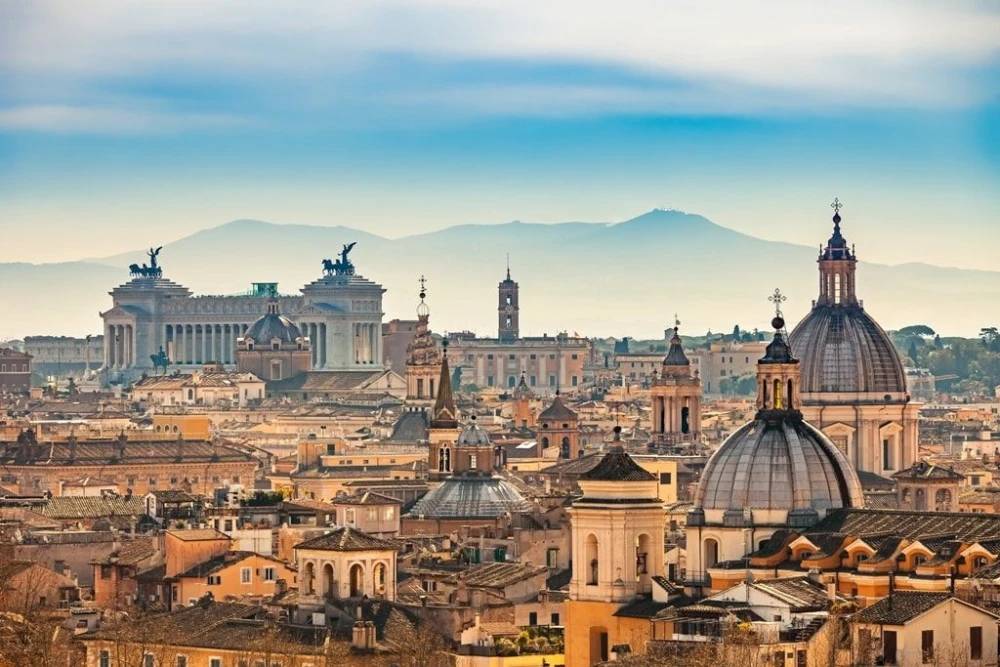15124, Maroysi, Athens, Greece

Copenhagen, Southampton, Lisbon, Valencia, Barcelona, Marseille (Provence), Civitavecchia (Rome), Alexandria, Aqaba, Muscat, Doha, Dubai
Approach Ports

Copenhagen, the capital of Denmark, was founded in the 12th century and owes much of its charm to the buildings erected by Denmark's monarchs, boasting a treasure trove of late-Renaissance and Rococo architecture. Built on a series of islands and islets, it is laced with graceful canals and boasts some of the most delightful architecture in Northern Europe. During your visit, you will see the fabled statue of Hans Christian Andersen's Little Mermaid, a symbol of the city that keeps a thoughtful watch on the harbor, stroll along the old harbor of Nyhavn, lined with cafés, restaurants and 500-year-old gabled houses, browse the superb shops on the world-famous Stroget or view the Rococo palaces lining Amalienborg Square. Best of all, savor the taste of local delicacies while wandering the paths of Tivoli Gardens, one of Europe's most celebrated pleasure gardens.
Southampton is the largest city of Hampshire on the south coast of England. Southampton is a major port. It was the point of departure for the RMS Titanic in 1912.
Lisbon, the capital of Portugal, on the southwest of the country, has been the main gateway for the rest of the planet for more than 19 centuries. Ships captained by Portuguese explorers like Bartolomeu Dias, Vasco da Gama and Ferdinand Magellan, skittered across the globe, hauling treasure home and making Lisbon a global capital. Draped across seven hills, Lisbon was once the center of a vast maritime empire that stretched from the west coast of Africa to the Spice Islands of the East Indies, until 1755, when a violent earthquake destroyed two-thirds of the city, leaving intact only the Alfama, the old Moorish quarter. Today, Lisbon is a stately city of Neoclassical buildings and wide plazas. Eternally linked to the sea, Lisbon's magnificent harbor is spanned by the longest suspension bridge in Europe. Among the city's landmarks are the iconic Castelo de São Jorge, the World Heritage Sites of Belém Tower and Jerónimos Monastery, both built in Lisbon's native Manueline architectural style.
Since its founding as a Roman colony in 138 B.C., the Visigoths, the Moors, the Catalan and Aragonese and the modern tomato-throwers have thrived on the shores of the Mediterranean at the Gulf of Valencia. Valencia is a mix of the old and the new. The historic past is depicted in the stone geometry of the Valencia Cathedral, the mediaeval gates of the Serrano and Quart towers, or the Tribunal de las Aguas (Water Court) and one of the most iconic examples of Gothic architecture in Europe, the Lonja de la Seda, declared an Intangible Cultural Heritage site by UNESCO. The new facet is embodied in the arching white steel of the futuristic City of Arts and Sciences, designed by Valencian architect Santiago Calatrava.

Barcelona is one of the world's greatest treasures, a global capital of commerce, fashion, culture and sunshine. Cruise visitors should start with a walk down Las Ramblas, the glorious tree-shaded thoroughfare at the heart of the city, enjoy a dive in the wonderful beaches nearby, but, most of all, see what visionary architect Antoni Gaudi wrought. Seven of his creations have been honored as UNESCO World Heritage Sites, including La Sagrada Familia, the Park Guell and Casa Mila. Time provided, you can also visit the former Olympic Ring on the hill of Montjuic, home to world-class parks, fountains and museums. Barcelona, which nurtured such artistic giants as Picasso, Dali, Miro and Casals, is definitely a traveler's paradise.

Marseille is the largest port on the Mediterranean, France's second largest city and a virtual melting pot of peoples and cultures. It is a unique city with a feel and culture all its own. It is also a place of striking contrasts, from the fishing boats of the picturesque Vieux Port to the modern Canebiere. Dominating the harbor is the infamous Chateau d'If, the rocky prison from which Alexandre Dumas' "Count of Monte Cristo" escaped. If you have time, explore the countryside around Arles and Avignon, immortalized in the canvases of Van Gogh, Cezanne, Matisse and Picasso, try the renowned bouillabaisse or tour the lovely towns and vineyards of Provence.

Our gateway to the Eternal City, Civitavecchia has served as Rome's seaport since the 13th century, boasting a long and venerable history. Its location near the modern city, made it a perfect vacation resort for emperor Trajan, who built a pleasure villa. while Bernini and Michelangelo designed the harbor fortifications. Yet the Eternal City, the ancient capital of the Western World and the center of Christianity for nearly 2.000 years, is our main reason to be here. YYou can visit the ruins of the Forum and the Colosseum, throw a coin in Fontana di Trevi to make sure you return to Rome one day, take a photo in front of the Vatican, view the splendors of the Sistine Chapel or climb the Spanish Steps, once the heart of Rome's Bohemian Quarter and enjoy a delicious gelato, in the glamorous area.

Founded in c. 331 BC by Alexander the Great, Alexandria became an important center of the Hellenistic civilization and remained the capital of Hellenistic and Roman & Byzantine Egypt for almost one thousand years. Alexandria flourished as the most important harbor and capital of Egypt and today is the second biggest city in the country. The Royal Library or Ancient Library of Alexandria, was one of the largest and most significant libraries of the ancient world. The impressive city wad built on the delta of the river Nile and often is characterized as the "bright pearl of the Mediterranean". It is filled with museums and provides access to the Pyramids and the Sphinx.
The seaside resort of Aqaba is located in the far south of Jordan and forms a great base from which to explore various places of interest in the South of the country and the Red Sea. Aqaba is a microcosm of all the good things Jordan has to offer, including a fascinating history with some outstanding sites - the Aqaba Fort (only outside), the Aqaba museum and a 4th c. roman church- , excellent hotels and activities, superb visitor facilities, good shopping and welcoming people. It is an aquatic playground, offering some of the best snorkelling and diving in the world. From Aqaba you can visit Petra, a World Heritage Site and Jordan's cultural treasure. You will be amazed as you pass through the Siq, a deep, twisting sandstone passage that leads you at al Khazneh ("The Treasury"), a monumental Greek-influenced edifice that emerges from the cliff. Among the sights, you will marvel the Street of Facades,the Roman Theater and the Monastery.
The capital and largest city of the Sultanate of Oman, Muscat is a beautiful Middle Eastern city offering visitors diverse attractions, a low-rise gem, wedged between Arabian Gulf and scenic mountains. Once ashore witness lavish palaces, Zawawi Mosque, its pink marble crowned by a gilded dome and Muttrah Souq, a jumble of crafts and clothing perfumed with spices and frankincense. Take time and explore Bahla Fort, a UNESCO World Heritage Site built in the 13th and 14th centuries, the impressive forts Al-Jalali, in the harbor of the old city of Muscat and Al Mirani, which overlooks the Sea of Oman, visit the spectacular Sultan Qaboos Grand Mosque, enjoy a stroll through Qurum National Park. Muscat also offers several museums and, further afield, the unique opportunity to watch camel racing and bull fights.
Doha is located on the coast of the Persian Gulf and is the capital city of the State of Qatar. Qatar is the world's richest and most cosmopolitan nation on the Arabian Peninsula. Doha, once a small port, today is full of impressive, towering buildings of strikingly modern architecture and luxury shops such as the Pearl or the Villaggio Shopping Mall. Visit the stunning Museum of Islamic Art which houses the largest collection of Islamic artifacts in the world and the unique Sheikh Faisal Bin Qassim Al Thani Museum with its magnificent exterior and its dazzling collections from cars to stamps and Islamic treasures.
Stretching along the southernmost shores of the Arabian Gulf, cosmopolitan Dubai is often described as a city of contrasts. On one side, sparkling tall buildings, glitzy shops and sun-soaked beaches of a glamorous seaside destination, on the other side, a city rooted in tradition and history. Wander the narrow streets of the Al Bastakiya historic district, where you can take in the sights and sounds of bustling souks (markets) or the quiet wonder of local mosques. Dubai is a wonderful word for shopping, in the most impressive shopping malls, such ast the Mall of the Emirates that also hosts the ski centre, and the Dubai Mall, which are a tempting world of shopping opportunities.
Itinerary







